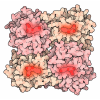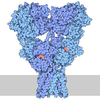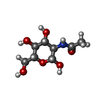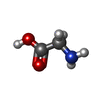[English] 日本語
 Yorodumi
Yorodumi- PDB-9boy: Cryo-EM structure of human Glycine Receptor apha3-beta heteromer ... -
+ Open data
Open data
- Basic information
Basic information
| Entry | Database: PDB / ID: 9boy | |||||||||||||||||||||
|---|---|---|---|---|---|---|---|---|---|---|---|---|---|---|---|---|---|---|---|---|---|---|
| Title | Cryo-EM structure of human Glycine Receptor apha3-beta heteromer with glycine in nanodisc | |||||||||||||||||||||
 Components Components |
| |||||||||||||||||||||
 Keywords Keywords | MEMBRANE PROTEIN / glycine receptor subunit alpha-3 / glycine receptor subunit beta / Green fluorescent protein | |||||||||||||||||||||
| Function / homology |  Function and homology information Function and homology informationglycine-gated chloride ion channel activity / acrosome reaction / synaptic transmission, glycinergic / glycine-gated chloride channel complex / Neurotransmitter receptors and postsynaptic signal transmission / gamma-aminobutyric acid receptor clustering / postsynaptic specialization / extracellularly glycine-gated ion channel activity / righting reflex / extracellularly glycine-gated chloride channel activity ...glycine-gated chloride ion channel activity / acrosome reaction / synaptic transmission, glycinergic / glycine-gated chloride channel complex / Neurotransmitter receptors and postsynaptic signal transmission / gamma-aminobutyric acid receptor clustering / postsynaptic specialization / extracellularly glycine-gated ion channel activity / righting reflex / extracellularly glycine-gated chloride channel activity / glycinergic synapse / adult walking behavior / glycine binding / startle response / neuropeptide signaling pathway / monoatomic ion transport / visual perception / presynaptic modulation of chemical synaptic transmission / chloride transmembrane transport / bioluminescence / generation of precursor metabolites and energy / transmitter-gated monoatomic ion channel activity involved in regulation of postsynaptic membrane potential / protein homooligomerization / GABA-ergic synapse / transmembrane signaling receptor activity / nervous system development / presynaptic membrane / perikaryon / chemical synaptic transmission / postsynaptic membrane / intracellular membrane-bounded organelle / dendrite / protein-containing complex binding / metal ion binding / plasma membrane / cytoplasm Similarity search - Function | |||||||||||||||||||||
| Biological species |  Homo sapiens (human) Homo sapiens (human) | |||||||||||||||||||||
| Method | ELECTRON MICROSCOPY / single particle reconstruction / cryo EM / Resolution: 3.81 Å | |||||||||||||||||||||
 Authors Authors | Liu, X. / Wang, W. | |||||||||||||||||||||
| Funding support |  United States, 1items United States, 1items
| |||||||||||||||||||||
 Citation Citation |  Journal: Nat Commun / Year: 2025 Journal: Nat Commun / Year: 2025Title: Mechanism of human α3β GlyR regulation by intracellular M3/M4 loop phosphorylation and 2,6-di-tert-butylphenol interaction. Authors: Xiaofen Liu / Malgorzata Krezel / Weiwei Wang /  Abstract: α3β glycine receptor (GlyR) is a subtype of GlyRs that belongs to the Cys-loop receptor superfamily. It is highly expressed in the spinal dorsal horn where sensory information is integrated. Under ...α3β glycine receptor (GlyR) is a subtype of GlyRs that belongs to the Cys-loop receptor superfamily. It is highly expressed in the spinal dorsal horn where sensory information is integrated. Under inflammatory conditions, the large unstructured intracellular M3/M4 loops of the α3 subunit are phosphorylated through the prostaglandin E2 (PGE) pathway, inhibiting ion conduction, and resulting in elevated pain sensation. A small molecule analgesic analog, 2,6-di-tert-butylphenol (2,6-DTBP) potentiates phosphorylated α3β GlyR through unclear mechanisms and relieves pain. Combining cryo-Electron Microscopy (cryo-EM) structures and single molecule Förster resonance energy transfer (smFRET) experiments, we show compaction of M3/M4 loop towards the ion conduction pore upon phosphorylation and further by 2,6-DTBP binding, which in turn modulates function through changing pore conformations and local electrostatics. We show that simultaneous interactions with the M3/M4 loop and the transmembrane domain (TM) is necessary for the potentiation of heteromeric α3β GlyR by 2,6-DTBP, while TM interaction alone is sufficient to potentiate homomeric α3 GlyR, explaining the mystery of why 2,6-DTBP potentiates only phosphorylated α3β GlyR. These findings show how post-translational modification of the unstructured intracellular M3/M4 loop may regulate Cys-loop receptor function, providing new perspectives in pain control and other pharmaceutical development targeting GlyRs and other Cys-loop receptors. | |||||||||||||||||||||
| History |
|
- Structure visualization
Structure visualization
| Structure viewer | Molecule:  Molmil Molmil Jmol/JSmol Jmol/JSmol |
|---|
- Downloads & links
Downloads & links
- Download
Download
| PDBx/mmCIF format |  9boy.cif.gz 9boy.cif.gz | 321.6 KB | Display |  PDBx/mmCIF format PDBx/mmCIF format |
|---|---|---|---|---|
| PDB format |  pdb9boy.ent.gz pdb9boy.ent.gz | 254.4 KB | Display |  PDB format PDB format |
| PDBx/mmJSON format |  9boy.json.gz 9boy.json.gz | Tree view |  PDBx/mmJSON format PDBx/mmJSON format | |
| Others |  Other downloads Other downloads |
-Validation report
| Arichive directory |  https://data.pdbj.org/pub/pdb/validation_reports/bo/9boy https://data.pdbj.org/pub/pdb/validation_reports/bo/9boy ftp://data.pdbj.org/pub/pdb/validation_reports/bo/9boy ftp://data.pdbj.org/pub/pdb/validation_reports/bo/9boy | HTTPS FTP |
|---|
-Related structure data
| Related structure data |  44754MC  9bozC  9bp7C M: map data used to model this data C: citing same article ( |
|---|---|
| Similar structure data | Similarity search - Function & homology  F&H Search F&H Search |
- Links
Links
- Assembly
Assembly
| Deposited unit | 
|
|---|---|
| 1 |
|
- Components
Components
| #1: Protein | Mass: 48936.520 Da / Num. of mol.: 4 Source method: isolated from a genetically manipulated source Source: (gene. exp.)  Homo sapiens (human) / Gene: GLRA3 / Production host: Homo sapiens (human) / Gene: GLRA3 / Production host:  Homo sapiens (human) / References: UniProt: O75311 Homo sapiens (human) / References: UniProt: O75311#2: Protein | | Mass: 76584.531 Da / Num. of mol.: 1 Source method: isolated from a genetically manipulated source Source: (gene. exp.)  Homo sapiens (human) / Gene: GLRB, MMB69_26960 / Production host: Homo sapiens (human) / Gene: GLRB, MMB69_26960 / Production host:  Homo sapiens (human) / References: UniProt: P48167, UniProt: A0A9X4KGN5 Homo sapiens (human) / References: UniProt: P48167, UniProt: A0A9X4KGN5#3: Sugar | ChemComp-NAG / #4: Chemical | ChemComp-GLY / Has ligand of interest | Y | Has protein modification | Y | |
|---|
-Experimental details
-Experiment
| Experiment | Method: ELECTRON MICROSCOPY |
|---|---|
| EM experiment | Aggregation state: PARTICLE / 3D reconstruction method: single particle reconstruction |
- Sample preparation
Sample preparation
| Component | Name: heteromeric glycine receptor alpha-3 and beta with glycine in nanodisc Type: COMPLEX / Entity ID: #1-#2 / Source: RECOMBINANT | |||||||||||||||
|---|---|---|---|---|---|---|---|---|---|---|---|---|---|---|---|---|
| Molecular weight | Value: 0.26 MDa / Experimental value: NO | |||||||||||||||
| Source (natural) |
| |||||||||||||||
| Source (recombinant) | Organism:  Homo sapiens (human) Homo sapiens (human) | |||||||||||||||
| Buffer solution | pH: 8 | |||||||||||||||
| Buffer component |
| |||||||||||||||
| Specimen | Conc.: 6 mg/ml / Embedding applied: NO / Shadowing applied: NO / Staining applied: NO / Vitrification applied: YES | |||||||||||||||
| Specimen support | Grid mesh size: 400 divisions/in. / Grid type: Quantifoil R1.2/1.3 | |||||||||||||||
| Vitrification | Cryogen name: ETHANE / Humidity: 100 % |
- Electron microscopy imaging
Electron microscopy imaging
| Experimental equipment |  Model: Titan Krios / Image courtesy: FEI Company |
|---|---|
| Microscopy | Model: FEI TITAN KRIOS |
| Electron gun | Electron source:  FIELD EMISSION GUN / Accelerating voltage: 300 kV / Illumination mode: FLOOD BEAM FIELD EMISSION GUN / Accelerating voltage: 300 kV / Illumination mode: FLOOD BEAM |
| Electron lens | Mode: BRIGHT FIELD / Nominal defocus max: 2500 nm / Nominal defocus min: 1000 nm / Alignment procedure: BASIC |
| Specimen holder | Cryogen: NITROGEN / Specimen holder model: GATAN LIQUID NITROGEN |
| Image recording | Electron dose: 69.6 e/Å2 / Film or detector model: GATAN K3 (6k x 4k) |
- Processing
Processing
| EM software | Name: PHENIX / Version: 1.21_5207: / Category: model refinement |
|---|---|
| CTF correction | Type: PHASE FLIPPING AND AMPLITUDE CORRECTION |
| Symmetry | Point symmetry: C1 (asymmetric) |
| 3D reconstruction | Resolution: 3.81 Å / Resolution method: FSC 0.143 CUT-OFF / Num. of particles: 40868 / Symmetry type: POINT |
| Atomic model building | Space: REAL |
| Atomic model building | PDB-ID: 8DN4 Accession code: 8DN4 / Source name: PDB / Type: experimental model |
 Movie
Movie Controller
Controller




 PDBj
PDBj










